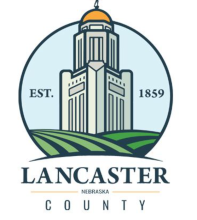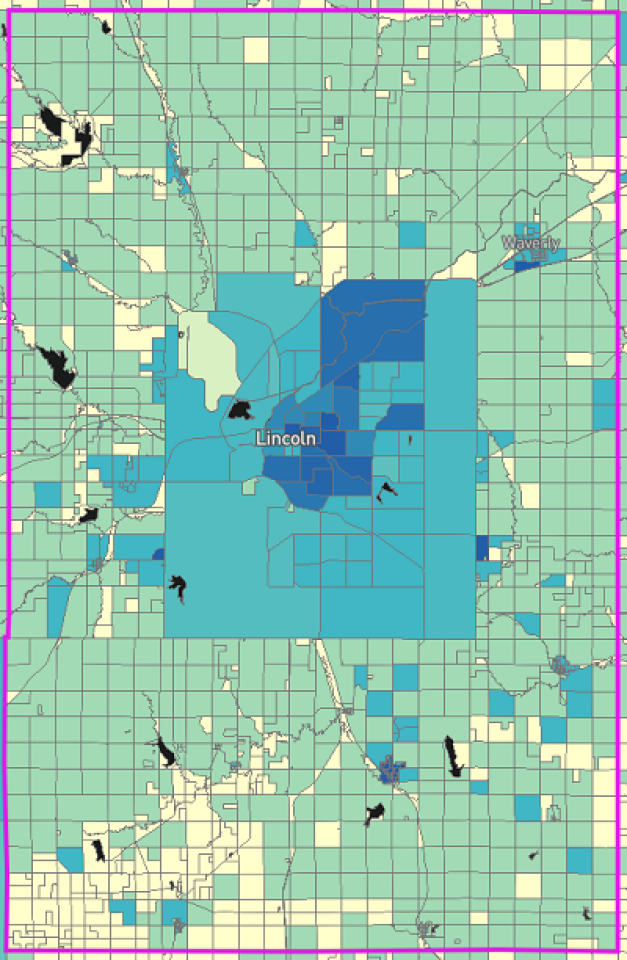
Fast, affordable Internet access for all.

About ten years ago, the city of Lincoln, Nebraska (pop. 285,000) began construction on a publicly owned conduit system it would eventually lease to Internet Service Provider (ISP) ALLO Communications to enable better Internet service options to residents. That project entered its final phase in the last two years, but local officials aren’t content to stop there.
Last fall, Lancaster County (pop. 316,000), of which Lincoln is the county seat, embarked on a new conduit system to multiply its success into the future. The expansion will build upon Lincoln’s network to initiate construction into the rural parts of the county and facilitate new connectivity options to three new cities, ten villages, two census-designated places, and nine unincorporated communities.

Not Content to Sit Still
Lancaster County is situated in the southeastern corner of the state, and the second-most populous one in Nebraska.
Fixed broadband coverage, seen in the FCC Form 477 map below, shows the reality locals are contending with; good coverage in the city proper, but few options once you move into the countryside.
Lincoln itself would be in much worse shape if not for the work of forward-thinking locals who began working on improving connectivity options almost ten years ago. The city of Lincoln and Lancaster County entered into an interlocal agreement back in 2014 as the basis for the creation of a joint Information Services Division designed to “offer cost effective solutions to exploit efficiencies and effectiveness throughout all agencies,” and spur future broadband investment. The effort has been successful (see table below) fostering better average connection rates than the U.S. as a whole, though just over 10 percent of households either have no Internet access or don’t pay for a subscription.
Building Upon the Past
That Interlocal Agreement was revised at the onset of the pandemic and flood of new federal funding to further increase its reach and benefit residents. The county and existing Information Services Division will play unique roles:
[Information Services] shall:
Create design, permitting, and bid packages for initial conduit construction;
Solicit bids for design and construction;
Select an engineering firm for design, and a contractor for construction, with County Board approval;
Manage the construction project;
Perform ongoing maintenance of conduit, and arrange for repairs when necessary, which shall be paid for directly by County;
Perform ongoing IS management of leases to ISPs;
Maintain records and financial documents as directed by County sufficient to evidence compliance with section 603(c) of the Social Security Act, Treasury’s regulations implementing that section, and guidance issued by Treasury;
Create and submit a budget for County Board approval by the first Friday in February annually; and
Perform all other duties necessary to achieve the purpose of the Program as agreed upon by the Parties.
County Responsibilities:
Pay all eligible costs for initial design and construction of the conduit using CLFRF;
Finance the ongoing operations of the Program, and maintenance of the conduit;
County’s Budget and Fiscal Office will manage and track all income and expenditures generated from the Program;
Ensure the Program’s compliance with the Treasury’s terms and conditions for CLFRF received from OMB Number 1505-0271, the Treasury’s Final Rule for State and Local Fiscal Recovery Funds Program, and section 603(c) of the Social Security Act. This includes fulfilling all reporting requirements;
The County Attorney will review all bidding, design, construction, and lease contracts to ensure compliance with the Treasury’s Final Rule and terms and conditions for CLFRF.
The County Attorney will negotiate all ISP leases, and design and construction contracts for the Program. All ISP leases and design and construction contracts are subject to County Board approval.
County’s Risk Management Office will procure and maintain any necessary insurance policies related to the Program’s operation, repairs, maintenance, and physical improvements.
The total cost of the expanded conduit network is estimated at $12 million for 170 miles of new construction, and the county plans to use funds from the State and Local Fiscal Recovery Fund (SLFRF) within the American Rescue Plan Act for most or all of it. Lancaster County Commissioner Rick Vest said of the project: “Our goal is to spread fiber through as much of the county as we can, to places that it wouldn’t otherwise be possible economically.”
The new conduit system would reach the cities of Hickman (pop. 2,400), Lincoln, and Waverly (pop. 3,900), the villages of Bennet, Davey, Denton, Firth, Hallam, Malcolm, Panama, Raymond, Roca, Sprague, the unincorporated communities of Agnew, Cheney, Emerald, Holland, Kramer, Martell, Prairie Home, Princeton, and Rokeby, and two census designated places: Walton and Yankee Hill. Collectively, it means better Internet access for tens of thousands of households in the rural parts of the county outside of the city of Lincoln. The proposed new routes (see map below) form a rectangular area about 50 miles long and half as wide.
The planning document says that the project could be completed eighteen months after construction begins.

Moving Forward
Lancaster County isn’t unique in pursuing projects like this, though it has been operational longer than most. West Des Moines, Iowa announced a little less than two years ago that it’s going to build an open access citywide conduit system with Google Fiber as the first anchor tenant.
It’s encouraging to see projects like Lancaster County’s move forward, and looks like it will provide a strong basis for improving local connectivity options. Today, the Lincoln conduit network provides residents with access to Nebraska-based ALLO Communications’ services, and can choose from symmetrical tiers of 500 Megabits per second (Mbps) for $70/month or 1 Gigabit per second (Gbps) for $99/month. It also returns significant funds to the city - projected at $2 million/year back in 2018.
There’s no word yet on which ISPs will lease the system to pull fiber and provide service, but ALLO would be a good bet. By all accounts it has built a positive relationship both with the city and with the subscribers it serves as it expands across the the region.
See more coverage of Lincoln’s conduit system here.
Broadband coverage map via FCC Form 477
Lanccaster County proposed conduit network map via project charter executive summary
Internet subscription rates via Census Reporter, based on ACS 2020 5-year data
